
The Manhattan Project was a research and development program undertaken during World War II to produce the first nuclear weapons. It was led by the United States in collaboration with the United Kingdom and Canada. From 1942 to 1946, the project was directed by Major General Leslie Groves of the U.S. Army Corps of Engineers. Nuclear physicist J. Robert Oppenheimer was the director of the Los Alamos Laboratory that designed the bombs. The Army program was designated the Manhattan District, as its first headquarters were in Manhattan; the name gradually superseded the official codename, Development of Substitute Materials, for the entire project. The project absorbed its earlier British counterpart, Tube Alloys. The Manhattan Project employed nearly 130,000 people at its peak and cost nearly US$2 billion, over 80 percent of which was for building and operating the plants that produced the fissile material. Research and production took place at more than 30 sites across the US, the UK, and Canada.

J. Robert Oppenheimer was an American theoretical physicist. He was director of the Manhattan Project's Los Alamos Laboratory during World War II and is often called the "father of the atomic bomb".
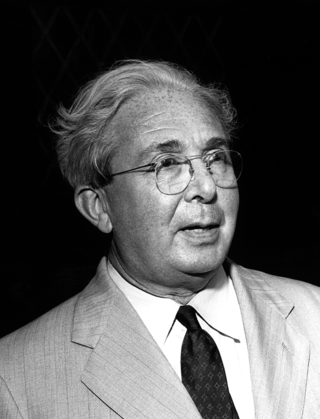
Leo Szilard was a Hungarian born physicist and inventor. He conceived the nuclear chain reaction in 1933, patented the idea in 1936, and in late 1939 wrote the letter for Albert Einstein's signature that resulted in the Manhattan Project that built the atomic bomb. According to György Marx, he was one of the Hungarian scientists known as The Martians.

Leslie Richard Groves Jr. was a United States Army Corps of Engineers officer who oversaw the construction of the Pentagon and directed the Manhattan Project, a top secret research project that developed the atomic bomb during World War II.
The Emergency Committee of Atomic Scientists (ECAS) was founded by Albert Einstein and Leó Szilárd in May, 1946, primarily as a fundraising and policy-making agency. Its aims were to warn the public of the dangers associated with the development of nuclear weapons, promote the peaceful use of nuclear energy, and ultimately work towards world peace, which was seen as the only way that nuclear weapons would not be used again.
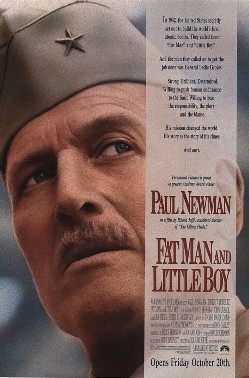
Fat Man and Little Boy is a 1989 American epic historical war drama film directed by Roland Joffé, who co-wrote the script with Bruce Robinson. The story follows the Manhattan Project, the secret Allied endeavor to develop the first nuclear weapons during World War II. The film is named after "Little Boy" and "Fat Man", the two bombs dropped on the Japanese cities of Hiroshima and Nagasaki, respectively.

The Smyth Report is the common name of an administrative history written by American physicist Henry DeWolf Smyth about the Manhattan Project, the Allied effort to develop atomic bombs during World War II. The subtitle of the report is A General Account of the Development of Methods of Using Atomic Energy for Military Purposes. It was released to the public on August 12, 1945, just days after the atomic bombings of Hiroshima and Nagasaki on August 6 and 9.
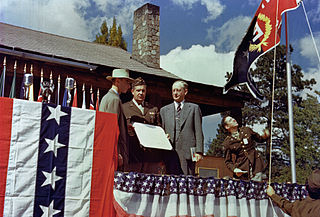
The Manhattan Project was a research and development project that produced the first atomic bombs during World War II. It was led by the United States with the support of the United Kingdom and Canada. From 1942 to 1946, the project was under the direction of Major General Leslie Groves of the US Army Corps of Engineers. The Army component of the project was designated the Manhattan District; "Manhattan" gradually became the codename for the entire project. Along the way, the project absorbed its earlier British counterpart, Tube Alloys. The Manhattan Project began modestly in 1939, but grew to employ more than 130,000 people and cost nearly US$2 billion. Over 90% of the cost was for building factories and producing the fissionable materials, with less than 10% for development and production of the weapons.
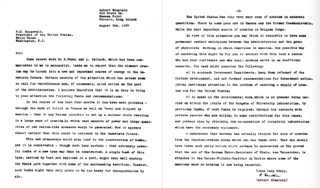
The Einstein–Szilard letter was a letter written by Leo Szilard and signed by Albert Einstein on August 2, 1939, that was sent to President of the United States Franklin D. Roosevelt. Written by Szilard in consultation with fellow Hungarian physicists Edward Teller and Eugene Wigner, the letter warned that Germany might develop atomic bombs and suggested that the United States should start its own nuclear program. It prompted action by Roosevelt, which eventually resulted in the Manhattan Project, the development of the first atomic bombs, and the use of these bombs on the cities of Hiroshima and Nagasaki.

The Szilárd petition, drafted and circulated in July 1945 by scientist Leo Szilard, was signed by 70 scientists working on the Manhattan Project in Oak Ridge, Tennessee, and the Metallurgical Laboratory in Chicago, Illinois. It asked President Harry S. Truman to inform Japan of the terms of surrender demanded by the allies, and allow Japan to either accept or refuse these terms, before America used atomic weapons. However, the petition never made it through the chain of command to President Truman. It was not declassified and made public until 1961.
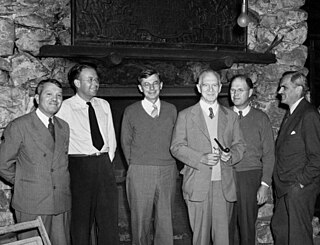
The S-1 Executive Committee laid the groundwork for the Manhattan Project by initiating and coordinating the early research efforts in the United States, and liaising with the Tube Alloys Project in Britain.

Hiroshima is a 1995 Japanese-Canadian war drama film directed by Koreyoshi Kurahara and Roger Spottiswoode about the decision-making processes that led to the dropping of the atomic bombs by the United States on the Japanese cities of Hiroshima and Nagasaki toward the end of World War II. The three-hour film was made for television and had no theatrical release.
The Atomic Heritage Foundation (AHF) is a nonprofit organization originally based in Washington, DC, dedicated to the preservation and interpretation of the Manhattan Project, the Atomic Age, and its legacy. Founded by Cynthia Kelly in 2002, the Foundation's stated goal is, "to provide the public not only a better understanding of the past but also a basis for addressing scientific, technical, political, social and ethical issues of the 21st century." AHF works with Congress, the Department of Energy, the National Park Service, state and local governments, nonprofit organizations and the former Manhattan Project communities to preserve and interpret historic sites and develop useful and accessible educational materials for veterans, teachers, and the general public. In June 2019, the Atomic Heritage Foundation and the National Museum of Nuclear Science & History signed an agreement that granted stewardship of the Atomic Heritage Foundation website and all of the AHF's physical collections to the museum. The Atomic Heritage Foundation website is now run by the National Museum of Nuclear Science & History. Additionally, the museum now houses the Atomic Heritage Foundation's physical collections which have been integrated into the Nuclear Museum's own collection.

The Beginning or the End is a 1947 American docudrama film about the development of the atomic bomb in World War II, directed by Norman Taurog, starring Brian Donlevy, Robert Walker, and Tom Drake, and released by Metro-Goldwyn-Mayer. The film dramatizes the creation of the atomic bomb in the Manhattan Project and the bombing of Hiroshima.
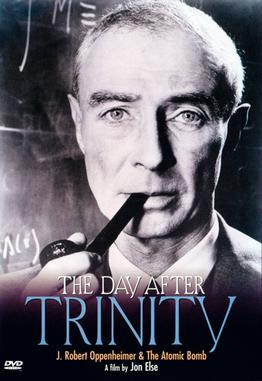
The Day After Trinity is a 1981 documentary film directed and produced by Jon H. Else in association with KTEH public television in San Jose, California.
"My Trial as a War Criminal" is a 1949 short story by atomic physicist Leo Szilard. Szilard had played a leading role in the Manhattan Project, and in the story he imagines the kind of show trial he might have had if he had been prosecuted in a manner similar to the Nuremberg Trials. Szilard earlier drafted the letter Albert Einstein signed, to Franklin Roosevelt, suggesting the US develop the military uses of nuclear power, and later the petition unsuccessfully advocating against the use of nuclear weapons.
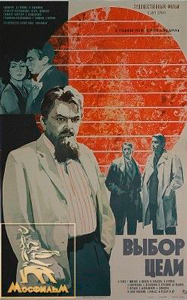
Take Aim is a 1974 two-part Soviet biographical drama film directed by Igor Talankin.
The Manhattan Projects is a science fiction comic book series co-created by writer Jonathan Hickman and artist Nick Pitarra published by Image Comics. The premise is an alternate history near the end of World War II in which the Manhattan Project was a front for other more esoteric science fiction ideas. The series is a monthly ongoing and began in March 2012 to much critical acclaim.

Britain initiated the first research project to design an atomic bomb in 1941. Building on this work, Britain prompted the United States to recognise how important this type of research was, helped the U.S. to start the Manhattan Project in 1942, and supplied crucial expertise and materials that contributed to the project's successful completion in time to influence the end of the Second World War.
Genius in the Shadows is a 1992 biography of Leo Szilard by William Lanouette. Leo Szilard was a Hungarian-German-American physicist who is most well known for discovering the nuclear chain reaction. The book covers Szilard's personal life and his work.















